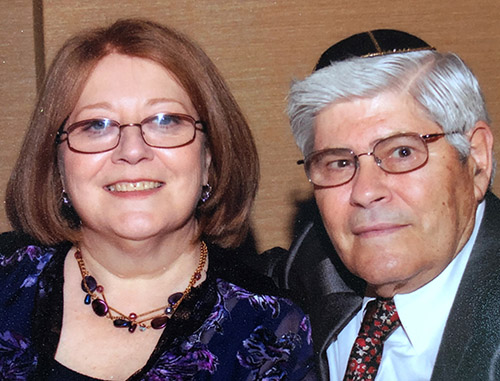


The newly renovated Maplewood Jewish Center (MJC) added a spectacular final touch to its 125- seat, high ceilinged sanctuary. Commissioned as a memorial to Isaac Ostrovsky, z”l, a stalwart of the MJC, a Ner Tamid shaped like a rose was hung above the Aron Kodesh on August 6.
“Everything fell into line,” said Ostrovsky’s wife Barbara, an artist and retired Newark public schools art teacher.
The idea came to Barbara as her husband lay ill. As usual, in their 47 years of marriage, she discussed such decisions with him. It gives her solace that Isaac knew and approved. She contentedly acknowledged, “He’d like it very much.”
To guide her through the grieving process, Barbara concentrated on studying about eternal lights and their designs. At her casual mention of commissioning the Ner Tamid, designed as a rose, her cousin Steven Fine, a Jewish scholar, suggested she read “The Thirteen Petalled Rose: A Discourse on the essence of the Jewish Existence and Belief” by Adin Steinsaltz, z”l, a Chabad rabbi who recently passed away. The book, Barbara said, “helped her decide how she wanted it designed.”
“There’s a lot of meaning in the rose,” she elaborated, and “the book is very philosophical, it speaks of the rose representing Knesset Israel, all Jews everywhere before and after.” Barbara commented that “many of the prayers said in synagogue refer to Knesset Israel, which is another way of saying God has light.” She further suggested that the Ner Tamid could be the light of anyone you love.
After researching artists on the internet, Barbara commissioned Claude Riedel after seeing his work. He worked with her to produce the perfect piece.
Before giving Riedel her final approval on the design, Barbara requested input from MJC spiritual leader Rabbi Sholom Bogomilsky and his wife, Frumie. After some slight modifications, the design was approved.
Looking at his rose bush outside the back door of their house, Barbara recalled that Isaac loved the fragrance of the yellow rose. He often brought a rose to minyan in the morning, and always took one off the bush for her.
Helping to design the piece to represent Isaac’s “openness and generosity of heart,” Barbara remarked, “just as with any artwork, you bring your own meaning to it, too.” Isaac, she asserted, warranted to be honored that way. As one of the synagogue’s cohanim, Isaac proudly blessed the congregation where he and his wife welcomed fellow congregants, new members and visitors with warm, broad smiles.
Isaac was born in Tanta, Egypt, but spent his childhood in Cairo. An only child, he emigrated to the United States in 1959 after the untimely death of his mother, which was coupled with a wave of anti-Semitism,. At age 25, with $45 in his pocket, he came on a visa with work lined up by his father’s friend in New Jersey. His father, a Polish Jew of Ashkenazi ancestry, was a prominent businessman in Egypt and an original member of the Free and Accepted Masons Lodge #1 in Alexandria, which Isaac later joined.
Fluent in Arabic, English, and French, Isaac, a successful businessman, retired in 2004, freeing up his time for cooking and entertaining. “Hospitable and generous,” said Barbara. “Most Sundays he would make traditional fūl for breakfast, and he often invited friends and fellow congregants for a lavish weekend brunch.”
Isaac learned how to cook by observing his Sephardic Jewish mother. Like his mother, Isaac enjoyed using his cooking skills. He prepared his homemade burgers, spiced with cumin and fresh parsley, whenever the synagogue lit up the grill for summertime holidays or fun days. His signature freshly made tabouli, full of chopped green sprigs, was served up with sage advice for getting the herbs ready by soaking them well.
For Passover, Isaac made batches of charoset and distributed containers of his classic fruit and nut mixture to neighboring friends, always standing by for a critique. To help fellow congregants through the Yom Kippur fast, he kept lemons speared with nutmeg for members to sniff.
Isaac was making minyans at MJC with his father-in-law and his wife’s uncle from the time he and Barbara moved to South Orange in 1972, where they raised their two daughters. Rachel, her husband and five children now reside in Israel; Claire, with her husband, lives in Arizona.
Much to Barbara’s delight, Rabbi Yossi Bogomilsky refers to the Ner Tamid hanging above the MJC bimah as “Isaac’s light.”
“Everything had meaning,” reported Barbara. The finished piece arrived on the day of the Rebbe’s yahrzeit, and Rabbi Steinsaltz died on the day she received a picture from Frumie of “Isaac’s light” hanging in the sanctuary.
The beautiful work of art is ready to shine on Isaac’s fourth yahrzeit, September 10 (21 Elul) and in perpetuity.
By Sharon Mark Cohen
�









